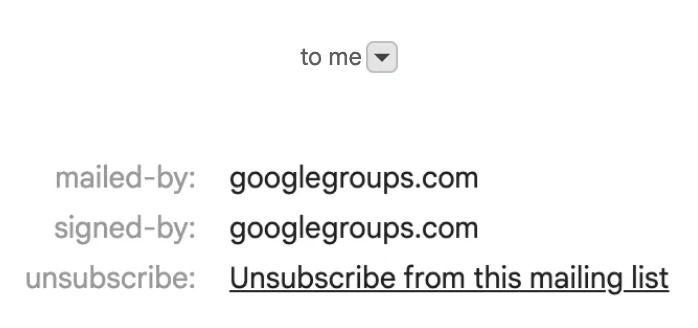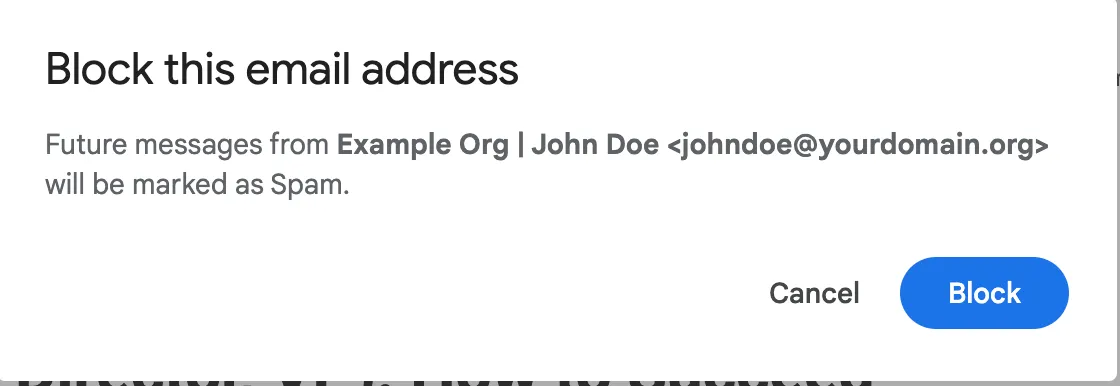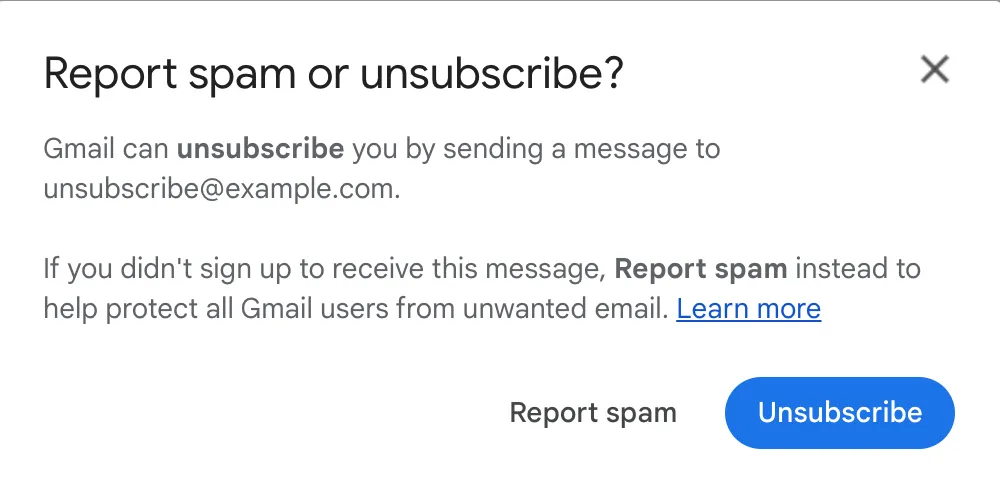Welcome back! Now that we‘ve covered what the guidelines are & why they most likely apply to you — and highlighted the new user-reported spam rate requirements — we‘re now going to dig into some of the terminology to unpack what Google actually says about any of this.
What does Google mean by “user-reported spam rates?”
When Google talks about user-reported spam rates, they are referring to the daily rate of user-reported spam as a percentage of total daily volume of email received from your domain and delivered to an active recipient’s inbox.
There’s actually a deceptive amount to unpack there, so let’s dig in to each of those component terms one at a time like we‘re back in a college comparative lit seminar.
What is meant by “total daily volume of email received from your domain?”
As we mentioned in our previous post, all email that your domain sends to Google recipients gets aggregated here — so if, on Tuesday, you personally send five emails from your own Google Workspace inbox, someone else on your team sends another 50 from Salesforce, and you send out a bulk ActionKit mailing whose audience includes 50,000 Gmail users, then your daily volume on Tuesday is 50,055.
Of course, the only mail that “counts” here is the mail you sent to a recipient who uses Gmail. Or has a @gmail.com account that they read in Outlook instead of the Gmail web app. (What about Google Workspace accounts on custom domains? It’s unclear!1) Or any other configuration of Gmail-ish Google mailbox products.
What about “delivered to an active recipient‘s inbox?”
The User Reported Spam page within Postmaster Tools has a tooltip that states this more clearly:
Emails delivered directly to the spam folder are not included in the spam rate calculation.
So if your message is going straight to spam, it will be ignored for the purposes of this calculation.2
The same tooltip also mentions active users, without defining that term:
This dashboard shows the percentage of user-reported spam vs emails that were sent to the inbox for active users.
At minimum, this certainly means that they will ignore messages sent to Google inboxes that don‘t exist or haven‘t been logged into for a long time. It‘s possible that there‘s more magic under the hood here, looking also at a user‘s past engagement with your messages and filtering out people who don‘t seem to be opening or clicking your mail at all.
The bottom line is that you should assume Google is calculating this pretty conservatively and using heuristics that you can‘t game in your favor — they want a metric of how many people who actually see your emails are deciding to mark them as spam.
Wait — what does “daily” mean?
Google Postmaster Tools’ daily calculations use UTC, so if you sent those five personal emails at 6:30 p.m. Pacific on Tuesday, then they actually counted toward your Wednesday volume as far as Google is concerned.
And what is meant by “user-reported spam?”
Gmail has a lot of ways for people to filter, unsubscribe, block, or otherwise complain about a message that they have received.
Not all of these are considered reporting spam. A user-reported spam complaint is just that: a time when a user actively marks your email as spam.
What is a spam complaint?
An unsubscribe is not a spam complaint
If the user unsubscribes from within Gmail this is not considered a spam complaint. In this case, you have politely provided your recipients with a way to unsubscribe, and your recipient has taken advantage of this feature to politely unsubscribe. So Google is happy!
Google provides a lot of ways for users to unsubscribe politely, like from the list of messages in the inbox:

And next to the sender’s displayed name and email address when you open the message:

And in the popover that appears when you click the little caret next to the recipient while the message is open:

Again – none of these count as a user-reported spam complaint, because the user isn’t complaining. They’re just unsubscribing.
A spam filter is not a spam complaint
On the flip side, if Google’s algorithms decide that your message was spam and send it straight to the recipient’s Spam folder so they never even see it, this is not considered a spam complaint either – the user did not report it as spam.
(However, as we mentioned above, these messages probably also don‘t count as mail delivered to the inbox; they’re probably ignored altogether for the purpose of calculating your spam rate.)
A spam complaint is a spam complaint
If – and only if – the user actually clicks “Mark as Spam” (or in some cases “Block”) then a user-reported spam complaint has occurred.
Note that in both of these cases, when polite unsubscribe options are properly implemented, Gmail’s user interfaces will really try to make the user think twice by displaying “Are you sure?” prompts.

They also steer the user toward politely unsubscribing instead wherever possible. Gmail really doesn’t want people to report spam casually!

How does Google say this all works in practice?
They kind of don‘t say anything. We are basing the below on what glimmers we can find, and we‘ll update this as we know more.
Does Google track spam complaints based on when the message was sent?
This is not well documented, but the consensus is that they don’t. A spam complaint counts toward the day that the user complained, not the day that you sent the offending message.
If you send a message on Tuesday, and the recipient marks it as spam on Friday, that complaint will count toward your Friday spam rate, even though the message was sent on Tuesday.
Scenario 1: If a single recipient reports five of my mailings as spam in a single UTC day, does Google count that as five user-reported spam complaints, or one?
We’re completely just guessing here, but our guess is that this counts as five complaints, even though they are all from the same recipient.
Scenario 2: Okay — what if a recipient marks a single one of my mailings as spam five times?
Note that this is actually pretty hard to do, but it is possible. (You can undo a spam report, and then redo it. Or you can open the message in multiple devices at the same time and mark as spam from both Gmail.com and your phone’s Gmail app.)
We’re still guessing here, but our guess is that this counts as one complaint, no matter how creatively the recipient does it.
Scenario 3: So if I send 5,000 mails on Tuesday, and then take a few days off from sending bulk mail, I may end up with very high user-reported spam rates for the next few days.
Yes — exactly.
Let’s say you send 5,000 mails to Gmail recipients on Tuesday, but most of them are on vacation.
Then on Friday, fifteen of your Tuesday recipients mark your message as spam while they’re catching up on their inbox.
Meanwhile, on Friday, you only send 300 messages to Gmail users, and fifteen of those recipients mark your message as spam right away.
In this scenario, you’ve sent 300 messages3 on Friday and received 30 spam complaints on Friday, so you may see a user-reported spam rate of 10% on Friday.
So — how do I know which recipients marked my mailing as spam? And how do I know which mailings they complained about? My bulk mailing tools tell me that, right?
Uhhh … hahaha … we tackle that next!
-
For what it‘s worth, our guess is that they all count toward your spam rate.
In other contexts Google does differentiate — for example, the new sender guidelines document itself says it will “help you successfully send and deliver email to personal Gmail accounts” and “a personal Gmail account is an account that ends in @gmail.com or @googlemail.com”.
As noted by GMass CEO Ajax Goel, the same intro paragraph in the guidelines had mentioned Google Workspace in a prior revision, so this definition was clearly intentional, and not an accidental omission.
That‘s talking about delivery — which recipients will be impacted by a failure to adhere to their guidelines.
We haven‘t seen any comparable language (personal gmail accounts, Google Workspace accounts, etc) on any of Google‘s official documentation about how they calculate the spam rate.
On the other hand, the Humans of Martech say that they‘ve heard only personal Gmail accounts get their complaints tracked here. But they also think this is likely to change sooner or later, so they agree that you can‘t just segment your @gmail.com recipients to manipulate this statistic. ↩︎
-
This is not so clearly stated everywhere. The Google Postmaster Tools FAQ seems like it would point in a different direction:
The spam rate is the percentage of emails marked as spam by users vs emails sent to the inbox for active users. If a substantial number of emails are delivered directly to spam folders, you may see a low spam rate even though users may still be marking your inboxed emails as spam.
This is not very clarifying! It seems to us that the logical implication of the second sentence here is that messages delivered directly to a spam folder do still count toward the denominator, rather than being ignored altogether. But other people we trust disagree and think that spam-foldered messages don’t count toward the denominator. The latter certainly seems a more common sense way to calculate it, and is more in line with what the tooltip says in the Postmaster Tools user interface, so we expect that’s right. ↩︎
-
You need to reach some daily volume threshold before Google will give you a daily spam rate at all. This is another of those undocumented details, but according to Iterable, the magic number here is 250: if you send to fewer than 250 Gmail recipients, Google won‘t provide you with a spam rate that day. (It‘s unclear whether they‘ll still calculate it for their internal use.) ↩︎
 The Third Bear
The Third Bear